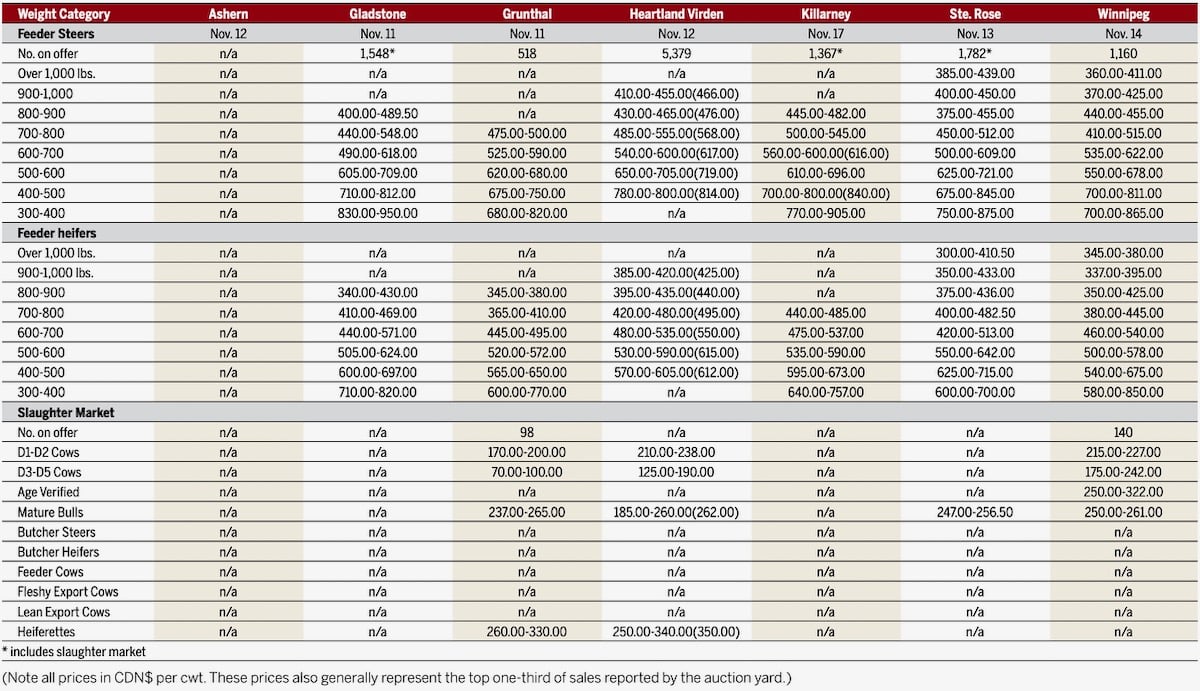The Port of Churchill, which closed for the season Nov. 12, was open almost two weeks later than usual and exported more than 600,000 tonnes of grain.
Merv Tweed, president of OmniTRAX Canada, which owns the port and the Hudson Bay Railway that serves it, said that while this year’s performance is encouraging, the port must still diversify if it is to survive.
That’s why OmniTRAX wants to export light sweet crude oil, said Tweed, who recently resigned as the member of Parliament for Brandon — Souris to head the firm.
Read Also

Manitoba cattle prices, Nov. 17
“I use the example of a shopping mall with anchor tenants,” Tweed said in an interview Nov. 15. “Grain would be one of our anchor tenants and we’re hoping oil would be the other and then that would allow us to do all the other things people want to do up here.”
Oil exported through Churchill would be shipped to Rotterdam to be refined, Tweed said.
Last year Churchill exported just under 432,500 tonnes of grain; the 10-year average is about 450,000 tonnes.
Churchill exported 656,298 tonnes in 2010 and the record was 729,000 tonnes sent in 1977.
This was Churchill’s longest shipping season since OmniTRAX purchased the port in 1997, Tweed said.
The port also loaded a couple of Panamax ships, which can carry 55,000 tonnes of grain.
Tweed said OmniTRAX is struggling to find rail cars to get grain into place at the northern terminal for next year’s shipping season.
Until last year almost all the grain shipped through Churchill came from the Canadian Wheat Board. There were dire predictions that exports through the port would dry up when the board’s monopoly was ended last year.
But the federal government stepped in with a $25-million shipping subsidy allocated over five years to assist with the port’s transition.
“What it does, is give us the opportunity to attract new grain companies and prove to them we can do what we say we’re going to do and give us the opportunity at the end of the day when the program expires,” Tweed said.
This year five grain companies shipped wheat, durum and canola through Churchill.
“We’re hoping we can expand that variety and supply markets we haven’t reached before,” he added.
Churchill, Canada’s only northern seaport, is about 1-1/2 days closer to some markets than Thunder Bay, Tweed said.
“To the shipping companies that’s a lot of money and a lot of savings,” he said.
Although Thunder Bay can load small ocean vessels, much of the grain shipped from there is transferred to other terminals along the St. Lawrence Seaway, adding cost.
Churchill’s disadvantage is its short season. This year the first ship arrived Aug. 4 and the last vessel usually sails by Oct. 31. This year’s Nov. 12 departure could be a sign of longer seasons to come. Arctic weather expert David Barber of the University of Manitoba has said Churchill’s shipping season could be extended by a month due to global warming.
“If we were to have a coast guard icebreaker, then that opens up a whole new area of possibilities,” Tweed said.
So would oil shipments — something environmental groups oppose. They question the safety given much of the Hudson Bay Railway is built on unstable permafrost. But Tweed said the railway has shipped petroleum products safely to Churchill’s fuel storage facility for years. Gasoline, diesel and aviation fuel is then shipped from Churchill to communities further north.
“We continue to move forward,” Tweed said. “We are having a series of community meetings with people along the rail line and listen to what they have to say and are showing them what we’d like to do and taking the feedback and adjusting accordingly.
“We have a company that is going to evaluate our business plan, safety plan and environmental plan. Whatever suggestions they make to improve it we’ll follow. We have taken a lot of steps to make it credible.”
The dream of establishing a northern seaport in Manitoba goes back more than a century. The Canadian Northern Railway laid track from Winnipeg to Hudson Bay Junction in 1908, but declined to head north despite federal government aid. With more government funds the next year, the railway began laying track to Nelson on Hudson Bay, but work ceased during the First World War.
When construction resumed it was decided to go farther north to Churchill. The Hudson Bay line was completed in September 1929 at a cost of $45 million. But it wasn’t until 1931 that the grain terminal at Churchill began operating.
















